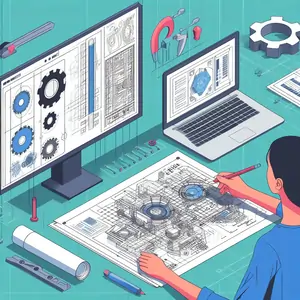In the dynamic landscape of design, AutoCAD stands as the linchpin, empowering students with the tools to envision and create intricate assemblies. As the demands of university assignments evolve, the integration of non-standard components has become pivotal. This guide serves as a beacon for students, illuminating the path to mastering the art of design assembly in AutoCAD, specifically focusing on the complexities of non-standard components. Here, students embark on a transformative journey, understanding not just the challenges but the immense creative opportunities that non-standard components offer. Each line, curve, and dimension becomes a canvas for innovation, and AutoCAD becomes the medium through which abstract ideas transform into tangible, digital realities. Through this exploration, students not only conquer university assignments but also lay the foundation for a future where they are adept designers, capable of turning the most intricate visions into awe-inspiring, real-world designs. Whether it's creating innovative structures or intricate mechanical designs, you'll find the tools you need to complete your assembly assignment using AutoCAD.

In this era of advanced technology and innovative design, mastering the intricacies of AutoCAD is not just an academic pursuit but a vital skill that defines the future of aspiring engineers and architects. University assignments, once confined to basic shapes, now demand a profound understanding of non-standard components, reflecting the demands of the professional world. This guide, "Design Assembly in AutoCAD: Mastering Non-Standard Components for University Assignments," is a comprehensive roadmap for students navigating this complex terrain. It serves as a comprehensive resource, unraveling the mysteries behind irregular polygons, intricate curves, and bespoke 3D models. By immersing themselves in the depths of design assembly, students not only unravel the challenges but also seize the boundless creative opportunities embedded in non-standard components. This guide is not merely a tutorial; it is a transformative experience, where students evolve from novices to adept designers, equipped to tackle the most intricate projects with finesse and innovation. Through this journey, they not only conquer university assignments but also carve a path toward a future where their designs shape the world’s architectural and engineering landscapes.
Understanding Non-Standard Components in AutoCAD
Understanding non-standard components in AutoCAD is akin to deciphering the language of innovation and complexity within the digital realm. Beyond the realm of conventional shapes, non-standard components encompass a universe of intricacies, from irregular polygons that defy traditional geometry to elegantly intricate curves that challenge the very notion of design limitations. These components, often bespoke and highly customized, represent the frontier of modern architecture and product design. Mastering them involves not just technical proficiency but a profound shift in perspective, encouraging students to visualize beyond the ordinary. It's about recognizing that within these complexities lies the essence of creativity and the foundation for groundbreaking designs. Through this understanding, students not only grasp the technical challenges but also embrace the immense opportunities for creativity and ingenuity that non-standard components offer, preparing them to excel not only in university assignments but also in the professional arena where innovative solutions are the currency of success.
The Essence of Non-Standard Components
Non-standard components, unlike basic shapes, encompass a wide array of intricacies. They range from irregular polygons and freeform curves to highly customized 3D models. In real-world applications, these components are omnipresent, defining modern architecture and product design. Understanding their essence is crucial; it's about visualizing beyond the traditional geometric constraints, and exploring designs that challenge the norm.
Challenges and Opportunities
Working with non-standard components presents challenges that foster innovation. From intricate measurements to detailing, each challenge is an opportunity to push creative boundaries. In these complexities lie opportunities to showcase problem-solving abilities, transforming a seemingly daunting task into a canvas for artistic and engineering ingenuity.
Advanced Tools and Techniques
AutoCAD, as the quintessential tool for computer-aided design, offers a plethora of advanced tools tailored for handling non-standard components. Parametric modeling allows for dynamic adjustments, ensuring precision in every design iteration. Surface analysis tools enable the creation of complex, curvilinear surfaces. Delving into these techniques empowers students to craft assemblies that are not just functional but aesthetically captivating.
Integrating Non-Standard Components in Assignments
Assignments often emulate real-world scenarios, demanding students to merge theoretical knowledge with practical skills. Integrating non-standard components isn't just a way to impress professors; it's about developing a skill set that prepares students for their future careers. This integration involves meticulous planning, conceptualization, and execution. From conceptual sketches to 3D modeling, each step requires attention to detail, transforming abstract ideas into tangible, digital realities.
Best Practices for Non-Standard Component Assembly
Embracing best practices for non-standard component assembly in AutoCAD is akin to honing the craft of digital sculpting; precision and finesse are paramount. It begins with an unwavering commitment to accuracy, where every measurement and angle is meticulously aligned to create a seamless integration of components. Collaboration and version control become guiding principles, reflecting the reality of the professional world where teamwork and iterative design are essential. Optimization and resource management emerge as crucial skills, ensuring that designs not only meet aesthetic standards but also operate efficiently within limited computational resources. Furthermore, documentation and presentation are elevated to an art form, where meticulous detailing and compelling visuals transform technical designs into persuasive narratives. Through these best practices, students not only ensure the flawless assembly of non-standard components but also cultivate a mindset of excellence and professionalism that distinguishes their work in both academic assignments and real-world applications.
Precision and Accuracy
In the realm of design assembly, precision and accuracy are paramount. AutoCAD provides tools like snap grids and object tracking, ensuring that every element aligns perfectly. Precision isn't just about measurements; it's about the seamless integration of components, where every angle and curve harmonize to create a cohesive whole. Mastering these tools guarantees that your assembly is flawless, down to the last pixel.
Collaboration and Version Control
AutoCAD's collaborative features facilitate group assignments, mirroring the collaborative environment of the professional world. Multiple designers can work on the same project simultaneously, fostering teamwork and diverse perspectives. Version control ensures that every design iteration is saved, allowing for seamless tracking of the project’s evolution. These features not only streamline group assignments but also prepare students for collaborative ventures in their careers.
Optimization and Resource Management
Efficient design assembly extends beyond aesthetics; it's about optimization. Non-standard components can be resource-intensive, impacting the overall performance of a design. AutoCAD provides tools for optimizing components, reducing file sizes, and enhancing performance. Understanding these optimization techniques is invaluable, especially when working on complex projects with limited computational resources. It’s about balancing creativity with efficiency, ensuring that designs are not just visually striking but also functional and responsive.
Documentation and Presentation
In the professional world, the ability to present designs convincingly is as crucial as the design itself. AutoCAD simplifies this process by offering tools for detailed documentation and stunning presentations. From generating precise engineering drawings to creating visually appealing 3D renderings, mastering these features elevates assignments to professional standards. It’s not just about what you design but how you present it that makes a lasting impression. Learning these skills transforms a simple assignment into a compelling narrative, showcasing both technical expertise and creativity.
Realizing Your Potential: Beyond Assignments
Realizing your potential in AutoCAD extends far beyond the confines of university assignments, reaching into the realms of boundless creativity and professional excellence. As you graduate from tackling assignments laden with non-standard components, you step into a world where your skills are not just measured by academic performance but by your ability to innovate and solve real-world design challenges. Continuous learning and skill enhancement become your guiding principles, propelling you towards mastering the ever-evolving features of AutoCAD. Building a diverse portfolio and engaging in personal projects cease to be mere academic exercises but transform into avenues for expressing your passion and creativity. These projects, be it designing sustainable structures or conceptualizing futuristic products, not only enhance your skills but also serve as a testament to your vision as a designer. Networking and industry exposure become your tickets to the professional arena, where collaborations and opportunities await. Embracing these aspects ensures that you don't just graduate with a degree but with a repertoire of skills and experiences that make you a formidable force in the world of design, ready to leave an indelible mark on the future.
Continuous Learning and Skill Enhancement
AutoCAD is a vast software with a myriad of features. Mastering it is a continuous journey. Beyond assignments, investing time in learning advanced tools, exploring plugins, and understanding industry trends is essential. Online tutorials, forums, and workshops are invaluable resources that can enhance skills and broaden horizons. A proactive approach to learning ensures that students are not just proficient but innovative, capable of tackling challenges that the future may hold.
Building a Portfolio and Personal Projects
A student’s journey with AutoCAD doesn’t end with university assignments. Building a diverse portfolio showcasing skills and creativity is essential. Consider taking up personal projects that challenge abilities. Whether it’s designing a unique furniture piece or conceptualizing an innovative product, these projects not only enhance skills but also serve as impressive additions to portfolios. They reflect passion, innovation, and the ability to think beyond conventional boundaries, catching the eye of potential employers and collaborators.
Networking and Industry Exposure
Networking is a powerful tool that can open doors to internships, job opportunities, and collaborations. Engaging with professionals in the field, attending industry events, and participating in online forums are avenues to showcase AutoCAD skills and discuss experiences in handling non-standard components. These interactions not only create lasting professional relationships but also provide insights into real-world applications, enriching understanding beyond academic scenarios.
Conclusion: Mastering the Art of Design Assembly in AutoCAD
Mastering design assembly in AutoCAD, especially with non-standard components, is not just about completing assignments; it’s about honing a skill set that propels students into successful careers. By understanding the nuances of non-standard components, adopting best practices, and realizing their potential beyond the classroom, students transform into designers capable of tackling any challenge.
As students delve into the intricate world of design assembly, they must remember that every project, every assignment, is an opportunity to learn, innovate, and excel. Embracing challenges, celebrating successes, and never ceasing to explore the boundless possibilities that AutoCAD offers will shape them into future design maestros, shaping the world one non-standard component at a time.
